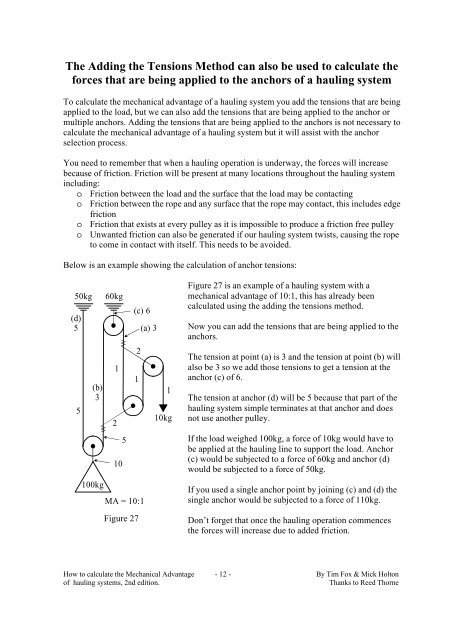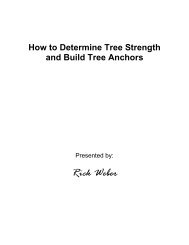Mechanical Advantage Paper.pdf
Mechanical Advantage Paper.pdf
Mechanical Advantage Paper.pdf
You also want an ePaper? Increase the reach of your titles
YUMPU automatically turns print PDFs into web optimized ePapers that Google loves.
The Adding the Tensions Method can also be used to calculate the<br />
forces that are being applied to the anchors of a hauling system<br />
To calculate the mechanical advantage of a hauling system you add the tensions that are being<br />
applied to the load, but we can also add the tensions that are being applied to the anchor or<br />
multiple anchors. Adding the tensions that are being applied to the anchors is not necessary to<br />
calculate the mechanical advantage of a hauling system but it will assist with the anchor<br />
selection process.<br />
You need to remember that when a hauling operation is underway, the forces will increase<br />
because of friction. Friction will be present at many locations throughout the hauling system<br />
including:<br />
o Friction between the load and the surface that the load may be contacting<br />
o Friction between the rope and any surface that the rope may contact, this includes edge<br />
friction<br />
o Friction that exists at every pulley as it is impossible to produce a friction free pulley<br />
o Unwanted friction can also be generated if our hauling system twists, causing the rope<br />
to come in contact with itself. This needs to be avoided.<br />
Below is an example showing the calculation of anchor tensions:<br />
50kg<br />
(d)<br />
5<br />
5<br />
(b)<br />
3<br />
100kg<br />
60kg<br />
1<br />
2<br />
10<br />
5<br />
(c) 6<br />
2<br />
1<br />
MA = 10:1<br />
Figure 27<br />
(a) 3<br />
1<br />
10kg<br />
Figure 27 is an example of a hauling system with a<br />
mechanical advantage of 10:1, this has already been<br />
calculated using the adding the tensions method.<br />
Now you can add the tensions that are being applied to the<br />
anchors.<br />
The tension at point (a) is 3 and the tension at point (b) will<br />
also be 3 so we add those tensions to get a tension at the<br />
anchor (c) of 6.<br />
The tension at anchor (d) will be 5 because that part of the<br />
hauling system simple terminates at that anchor and does<br />
not use another pulley.<br />
If the load weighed 100kg, a force of 10kg would have to<br />
be applied at the hauling line to support the load. Anchor<br />
(c) would be subjected to a force of 60kg and anchor (d)<br />
would be subjected to a force of 50kg.<br />
If you used a single anchor point by joining (c) and (d) the<br />
single anchor would be subjected to a force of 110kg.<br />
Don’t forget that once the hauling operation commences<br />
the forces will increase due to added friction.<br />
How to calculate the <strong>Mechanical</strong> <strong>Advantage</strong> - 12 - By Tim Fox & Mick Holton<br />
of hauling systems, 2nd edition.<br />
Thanks to Reed Thorne



